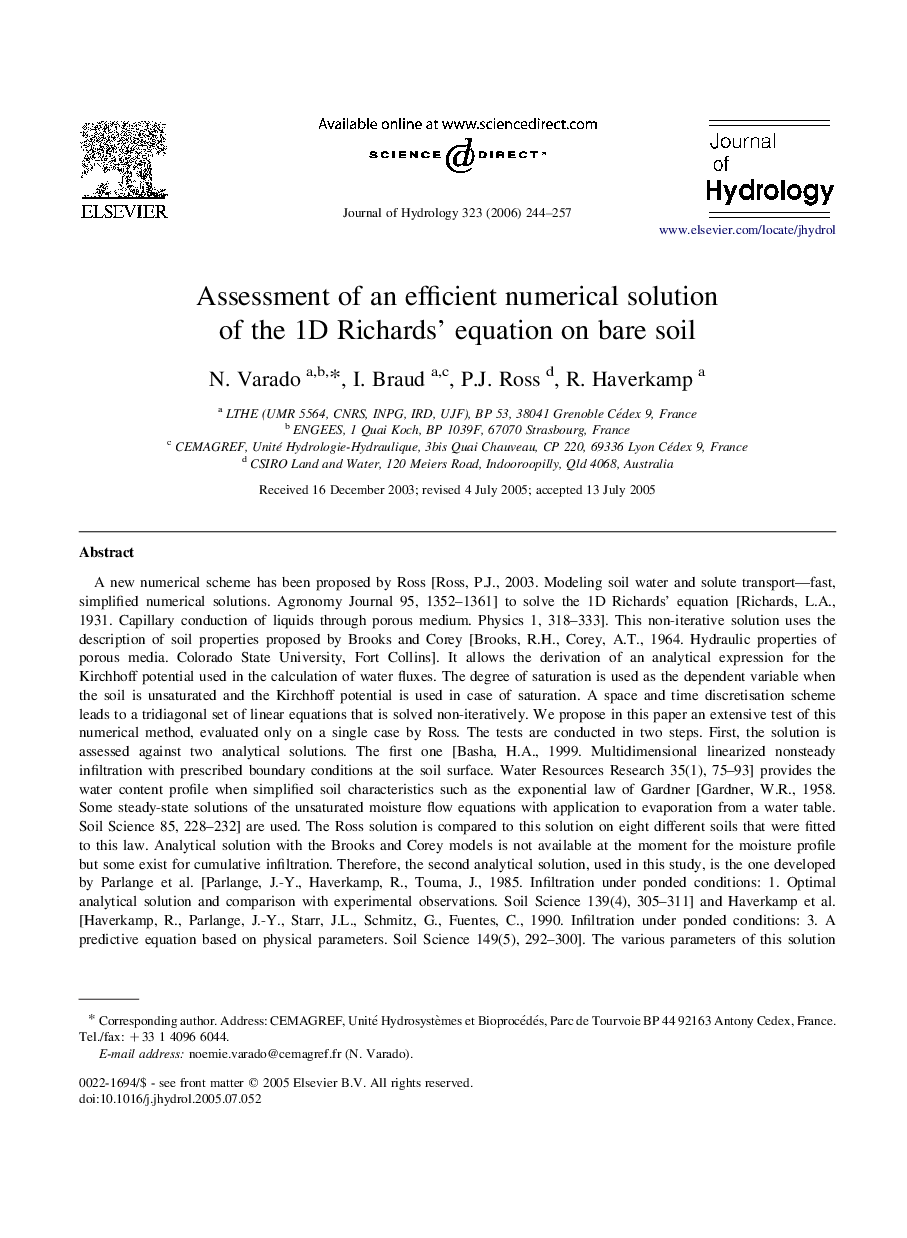| کد مقاله | کد نشریه | سال انتشار | مقاله انگلیسی | نسخه تمام متن |
|---|---|---|---|---|
| 4580632 | 1630165 | 2006 | 14 صفحه PDF | دانلود رایگان |

A new numerical scheme has been proposed by Ross [Ross, P.J., 2003. Modeling soil water and solute transport—fast, simplified numerical solutions. Agronomy Journal 95, 1352–1361] to solve the 1D Richards' equation [Richards, L.A., 1931. Capillary conduction of liquids through porous medium. Physics 1, 318–333]. This non-iterative solution uses the description of soil properties proposed by Brooks and Corey [Brooks, R.H., Corey, A.T., 1964. Hydraulic properties of porous media. Colorado State University, Fort Collins]. It allows the derivation of an analytical expression for the Kirchhoff potential used in the calculation of water fluxes. The degree of saturation is used as the dependent variable when the soil is unsaturated and the Kirchhoff potential is used in case of saturation. A space and time discretisation scheme leads to a tridiagonal set of linear equations that is solved non-iteratively. We propose in this paper an extensive test of this numerical method, evaluated only on a single case by Ross. The tests are conducted in two steps. First, the solution is assessed against two analytical solutions. The first one [Basha, H.A., 1999. Multidimensional linearized nonsteady infiltration with prescribed boundary conditions at the soil surface. Water Resources Research 35(1), 75–93] provides the water content profile when simplified soil characteristics such as the exponential law of Gardner [Gardner, W.R., 1958. Some steady-state solutions of the unsaturated moisture flow equations with application to evaporation from a water table. Soil Science 85, 228–232] are used. The Ross solution is compared to this solution on eight different soils that were fitted to this law. Analytical solution with the Brooks and Corey models is not available at the moment for the moisture profile but some exist for cumulative infiltration. Therefore, the second analytical solution, used in this study, is the one developed by Parlange et al. [Parlange, J.-Y., Haverkamp, R., Touma, J., 1985. Infiltration under ponded conditions: 1. Optimal analytical solution and comparison with experimental observations. Soil Science 139(4), 305–311] and Haverkamp et al. [Haverkamp, R., Parlange, J.-Y., Starr, J.L., Schmitz, G., Fuentes, C., 1990. Infiltration under ponded conditions: 3. A predictive equation based on physical parameters. Soil Science 149(5), 292–300]. The various parameters of this solution are written for the Brooks and Corey models and the cumulative infiltration calculated by the Ross solution is compared to this analytical solution.The second part of the test is a comparison with a reference model: the SiSPAT (Simple Soil Plant Atmosphere Transfer) model, which provides a reference iterative solution of the soil water flow equation. A wide range of simulations is performed, with various soil types (homogeneous or not), various climate forcing and several initial conditions. It allows the comparison of various variables such as deep drainage, soil moisture profile, surface ponding, and evaporation under non-uniform initial moisture content and time varying climate forcing.We show that the model provides robust and accurate solutions as compared with the analytical solutions and with the SiSPAT model. This study also shows that a finer discretization than the one proposed by Ross is necessary close to the soil surface to accurately model the cumulative infiltration, especially for clayey soils.
Journal: Journal of Hydrology - Volume 323, Issues 1–4, 30 May 2006, Pages 244–257